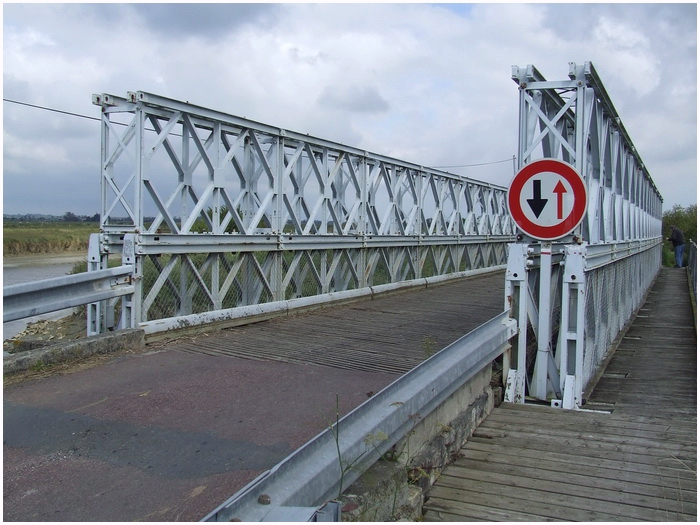
THE BAILEY BRIDGE
Somewhere in Normandy, I was told, was a Bailey bridge.
I searched for a couple of years, but thanks to ‘Goggle Earthe’, I finaly found it.
I like to share the location with you. The Bailey can be found northeast of Carentan.
Leave the highway N 13 at the exit Carentan. When you drive into the village of
Saint-Hilaire-Petitville, take on the roundabout the first lane (keep right).
After the second bridge, go right, towards the harbor. This part is still
Saint-Hilaire-Petitville. Keep right on the harbor/canal and drive this road
500 yards (mind the bump halfway in this road!... this is the viaduct across the N 13).

The Bailey bridge of Saint-Hilaire-Petitville is laid across the
river Taute, after the original bridge was blown by the Germans. The 300th Combat
Engineer Battalion built the Bailey. During the construction, Major John Tucker was
killed on June 27, 1944, when Germans fired at it. In remembrance of this, the
bridge was called Tucker Bridge (there is also a Rue John Tucker in the village).

June, 1944, the Bailey bridge is constructed and traffic is crossing it
Then and Now
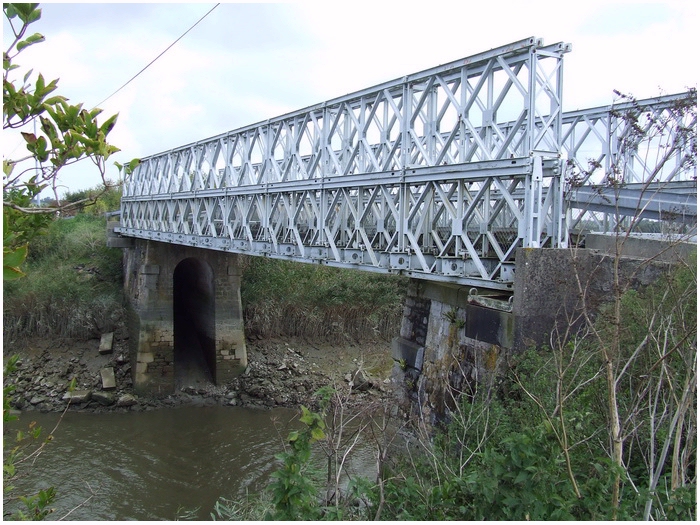
The Bailey bridge at Saint-Hilaire-Petitville is a unique piece of
the Second World war and is still in use by the locals. The quality of the bridge is remarkable.
Under the flaking paint, the original green paint visible. What is evident was the lack of all
the construction elements when it was built. In stead of the original securing pins, at some
places they had to use standard nails (see picture below).
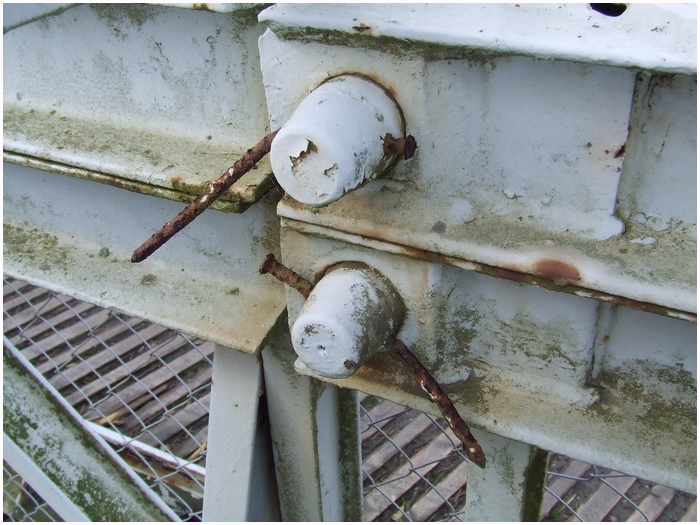
Improvisation was what Army Engineers were best in;
use nails if securing
pins are not around
More on Bailey bridges:
CLICK HERE
'FILTHY
13'
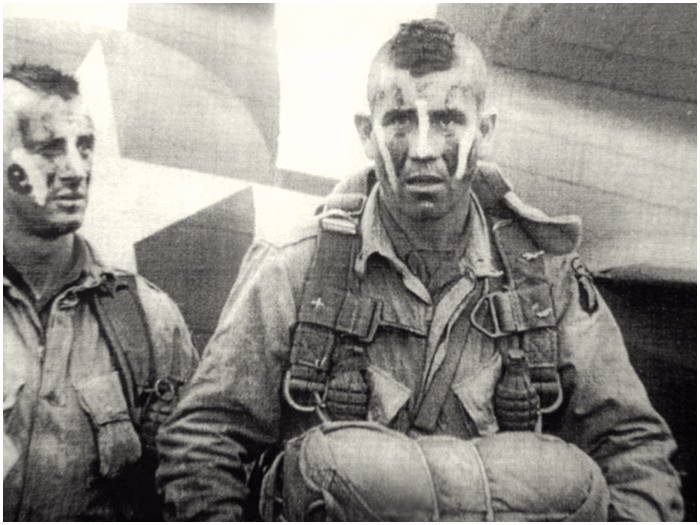
John Hale and Thomas Lonergan, 3rd Bat.,
506th PIR (RHQ), Exeter June 5, 1944
After you have visited the Bailey bridge, I advise you to drive a kilometer
further towards
Brèvands. In Le Moulinis to be found, since 2009 a monument for the actions
made by the
3rd Battalion, 506th PIR, 101st Airborne Division and C-Company
326th Airborne Engineer Battalion and the Regimental
Demolitions Squad, and were at the time already known under the name
‘Filthy Thirteen’. Her nickname came from the attitude and discipline, or lack of it, shown
by the men during their ‘work’. The men in this outfit did not exactly what the army wanted
from then, but during their work, they did more than the army expected from then.
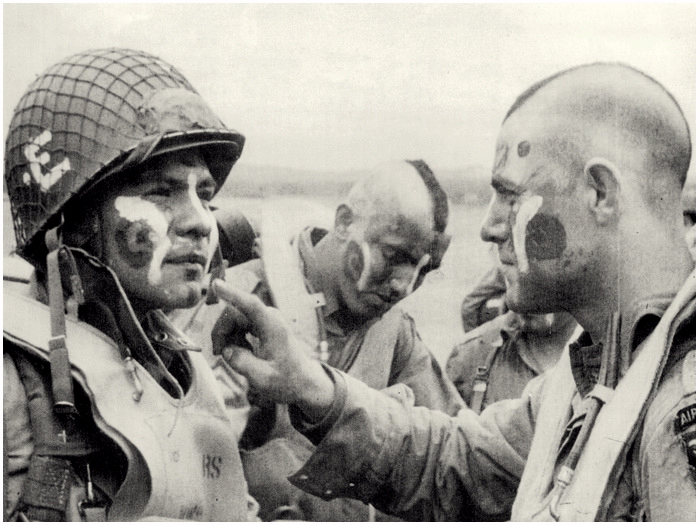
Jake McNiece (right) paints the face of
Mariano Ferra from C-Comp., 326th AEB
(notice the letter
'E' for Engineer Battalion on the helmet)
The idea came from Jake McNiece,a half breed indian from Oklahoma,
who suggested to cut their hair in a ‘mohawk’ and paint their faces. And so, just before they
departed, they helped each other into ‘war outfits’, and painted their faces, by lack of
enough paint, also with paint used original for invasion stripes on the aircraft
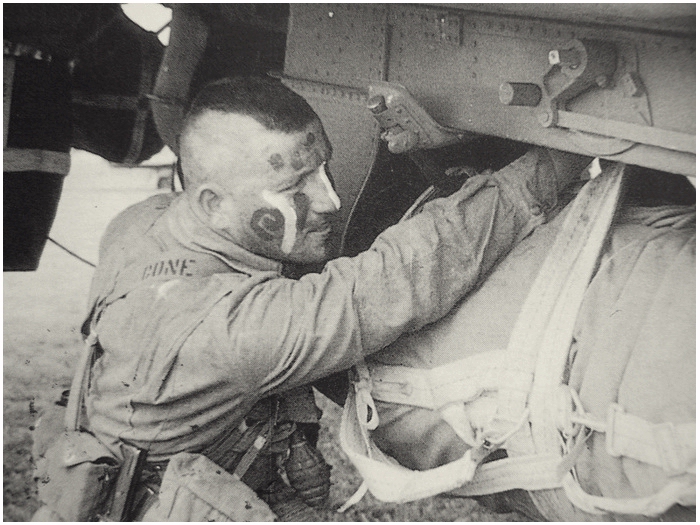
Robert S. Cone checks once again one of the six
'parapacks' beneath the C-47.
These contained other heavy weapons, extra ammo and demolition charges
The 575 paratroopers left, in fifty four C-47’s from 440th Troop Carrier Group
to Drop Zone ‘D’ near Angoville-au-Plain, in the night of 5 and 6 June, 1944. Target for this
outfit were two bridges near Le Port, to take them, secure them, and stop any German opposition
who would use these bridges to threaten the bridgehead at Utah Beach. Also, the Allies
had in mind to use these bridges in time as an extra road towards Omaha Beach.
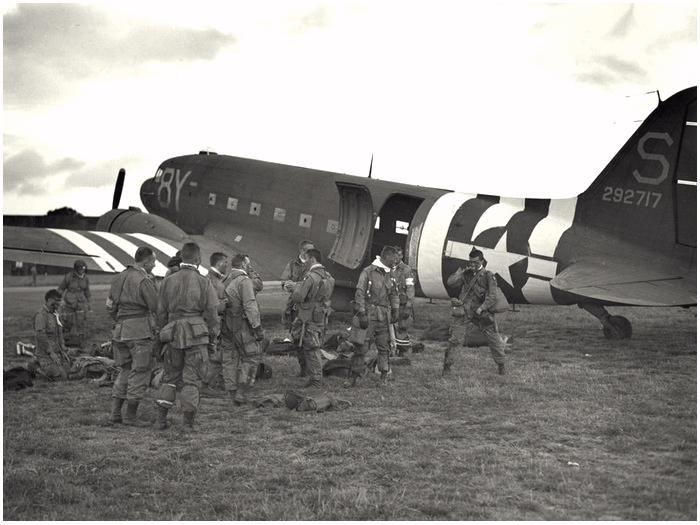
Col. Robert L. Wolverton, CO and his HQ
'stick', 3rd Batt., 506th PIR
will board soon into 'STOY HORA',
C-47 '292717' (June 5, 1944, Exeter, England).
This aircraft is the
leading plane (#1) of the 440th Troop Carrier Group,
flown by
Col. Frank X. Krebs, 440th TCG CO
The jump into the dark was not without cassulties, 93 men were killed during
the first hours, because of missing their dropzone or were killed by enemy fire. Under the victims
were also the commander of the outfit, Lt.-Col. Robert L. Wolverton, and the commander of G-Company,
Capt. Harold van Antwerp. Captain Robert Harwick, commander of H-Company and the commander of
I-Company, Capt. John McKnight were taken prisoner by the Germans.
(Later, Harwick managed to escape, and returned to his command of the battalion
again on June 8).

The red stripes on the map, are the positions of
the bridges
During first light, a group of thirty men, under command of Capt.
Charles Shettle reached the bridges. But the Germans still had a firm grip on the bridges,
and the paratroopers had to retreat. The Germans had placed charges on the bridges, and could
be blown if necessary. When on June 7, the commander of 506th, Col. Robert F.Sink had still noting
heard of the 3rd Battalion, the order is given to destroy the bridges. Two squadrons of
fighter-bombers dropped their bombs, which completely destroys the bridges. The Germans could
not use these bridges anymore, bot also for the Allied troops lost their route towards Omaha Beach by these bridges.
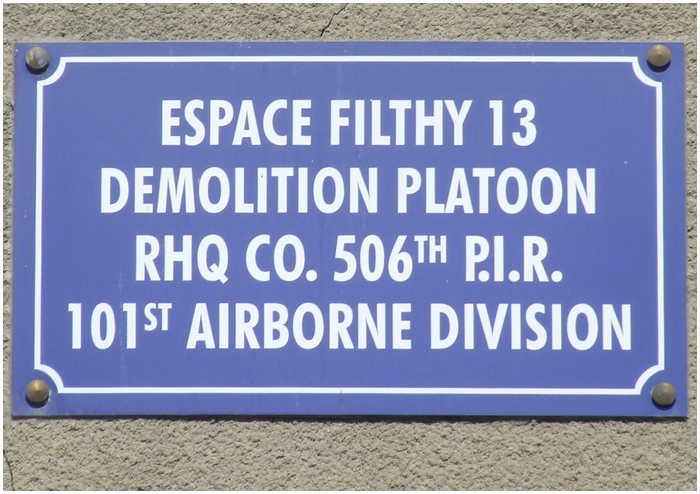
A plaque on a wall tells where the monument is located
During the period the 3rd Battalion operated in this area (and consisted
in the end of 150 men), a couple of German attacks where stopped. The attacks cost the Germans dearly,
at least 70 to 80 died, and 258 Germans were made prisoner. During the evening of June 8, the 3rd
Battalion was relieved by the 327th GIR (Glider Infantry Regiment). During two days of fighting,
7 paratroopers were killed, and 21 wounded (of the 150). Four men received the
DSC (Distinguished Service Cross); Lt. Charles Santasiero (I-Company), Srgt. George
Montilio (H-Company), Pvt. F.Cl. Donald Zahn (H-Company) and
Pvt Fst Cl. Andrew Sosnak of the medical section.
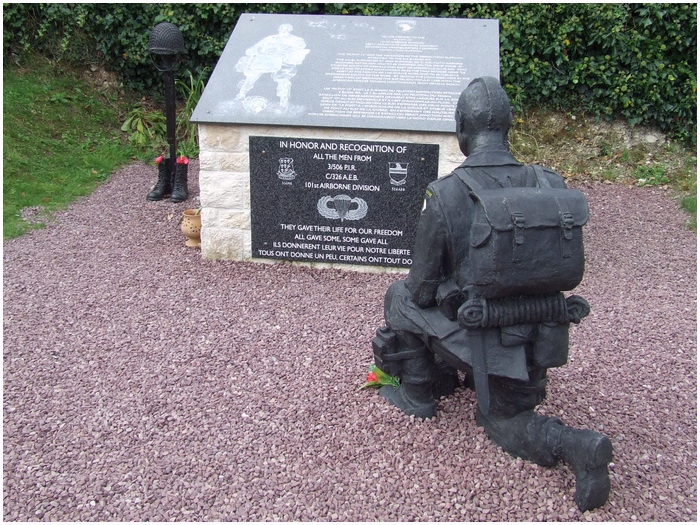
The monument for the 3rd Battalion can be found in the Espace
Filthy 13, at the crossraod of Le Moulin, heading towards Brèvands.
Two heavy stone plaques placed on top of feet made of bricks. On the plaques are
told the exploits and remembrance of the 3rd Battalion. A fantastic engraving of a paratrooper
is the most eye-catching on one of the plaque. The trooper, with ‘mohawk’ and painted face, was made by the artist
C. Salembier. In the tiny park, a tree was also planted for peace, it stands beside a large sign which
has more on the exploits of the 3/506th PIR and the ‘Filthy 13’.
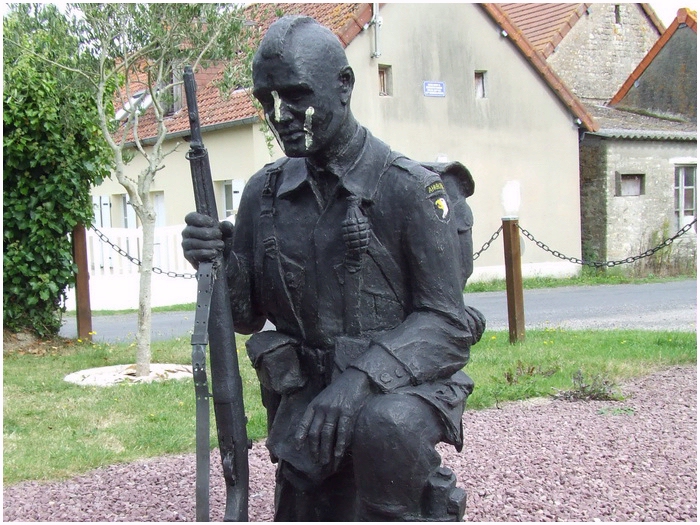
It has the appearance of a bronze statue, but it's plastic
A couple of years after the monument was erected in 2009, a statue of a kneeling paratrooper was placed in front
of the large plaque. Next to the plaque a rifle, between two jumpboots, with a helmet resting on it, can be found.
It looks very impressive,... but if you tap against the new items placed here,... it is not made out
of bronze, but some kind of plastic. I figure that this is on purpose, because real bronze is
a sought of material by bronze-thiefs.

Corporal Joseph J. 'Joe' Oleskiewicz,
3rd Bat., 506th PIR (RHQ).
(He was killed in Holland on September 30, 1944)
RETURN
|